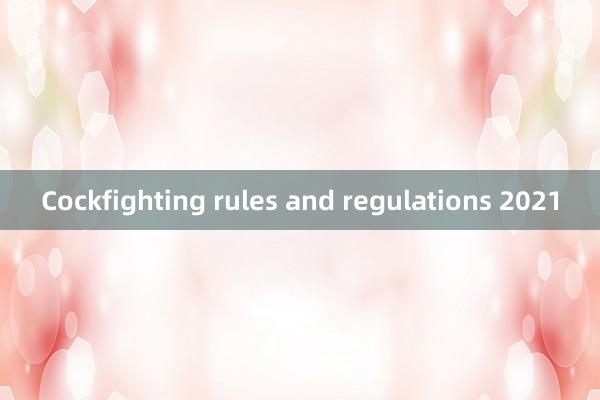
Cockfighting Rules and Regulations 2021: An In-Depth Guide
Cockfighting, a controversial and often illegal activity in many parts of the world, has a long history tied to cultural traditions and regional practices. Although many countries have moved towards banning the practice due to animal cruelty concerns, some regions still maintain organized cockfighting events. Understanding the rules and regulations that governed cockfighting in 2021 is essential, especially for those involved in the sport where it remains legal. This guide explores the key rules, regulations, and regional variations that shaped cockfighting practices in that year.
Cockfighting is a competitive event where two roosters, often specifically bred for aggression, are placed in an enclosed arena to fight. The matches are typically conducted until one of the birds is either incapacitated or killed. Spectators place bets, making the event not only a sporting competition but also a gambling activity. The practice has existed for centuries, with roots in ancient Greece, Rome, and various Asian cultures.
In 2021, regulations surrounding cockfighting varied significantly from country to country and even within regions of the same nation. Several countries had strict bans, while others allowed cockfighting under specific conditions.
In 2021, cockfighting remained legal in some countries, particularly in parts of Asia, Latin America, and the Caribbean. The Philippines, for example, has one of the largest cockfighting industries in the world, where the sport is heavily regulated by the government. Sabong, as it is known locally, is deeply rooted in the culture, bongdalu fun and licensed cockpits (arenas) are used to conduct official matches. Government agencies monitor these events, bw777 ensuring that regulations are followed to protect the integrity of the sport and the animals involved.
Other countries such as Mexico,200jili some regions of Puerto Rico, and parts of Indonesia also allowed cockfighting, often as a cultural practice or festival. In these areas, specific regulations were implemented to manage betting activities and the treatment of animals. These measures often required organizers to hold licenses and register events with local authorities.
In contrast, many countries, including the United States, the United Kingdom, and most of Europe, maintained strict bans on cockfighting. These laws were enforced to prevent animal cruelty and were supported by various animal welfare organizations. The U.S., for example, prohibited cockfighting nationwide, including in territories such as Puerto Rico. Violations of these laws resulted in severe penalties, including heavy fines and imprisonment.
Where cockfighting remained legal in 2021, the sport was often governed by specific rules designed to ensure a fair competition and regulate the safety of both the participants and spectators. Here are some of the common rules enforced:
Roosters bred for fighting were selected based on their aggressiveness, strength, and stamina. In places where cockfighting was legal, breeders were often required to register their birds with local authorities. This practice helped ensure that only roosters suitable for fighting, and those who met health standards, were allowed in official matches.
Before the match, the birds would undergo an inspection process. Officials checked the roosters for any signs of tampering or artificial enhancements, such as steroids or sharpened spurs that could unfairly alter the outcome of the fight. This inspection aimed to maintain fairness and prevent cheating.
Just like in professional boxing or mixed martial arts, weight classes and fair match pairings were crucial in cockfighting. Roosters of similar size and weight were matched to ensure the competition was balanced. Organizers regulated this aspect to minimize mismatches and provide an equal opportunity for each bird to win.
In some regions, the use of metal spurs or gaffs was allowed, while in others, the roosters fought only with their natural spurs. In legal cockfighting venues, the type of spur used was often regulated. Officials monitored these regulations to prevent unnecessary harm to the animals and control the level of violence in each match.
Most organized cockfighting events had set time limits. If no rooster was incapacitated within the given timeframe, the match could either end in a draw or go into a sudden death overtime round. In some places, if both roosters were deemed unfit to continue, a draw would be declared, and any betting activity would be managed accordingly.
Despite the legality of cockfighting in some regions, there were ongoing efforts in 2021 to promote animal welfare and minimize the brutality of the sport. In countries where cockfighting was legal, authorities imposed regulations to mitigate cruelty, such as banning illegal performance-enhancing drugs and restricting the type of weapons allowed during matches. There were also measures to ensure the birds received proper care before and after the fights, including veterinary check-ups and humane euthanasia when necessary.
In places where cockfighting was banned, authorities made efforts to crack down on underground events. Enforcement typically involved surveillance, raids, and the seizure of birds and equipment. Participants in illegal cockfighting activities faced prosecution, with penalties ranging from fines to imprisonment. This was particularly evident in countries like the U.S., where animal welfare organizations collaborated with law enforcement to eradicate the practice.
As of 2021, the future of cockfighting regulations remained uncertain. While many countries and regions moved towards stricter bans and enforcement measures, there were still places where the sport was thriving as part of a deeply embedded cultural tradition. International organizations advocating for animal rights continued to push for global bans and stricter regulations, emphasizing the need for compassion and ethical treatment of animals.
Cockfighting in 2021 was governed by a complex web of rules and regulations that varied significantly depending on location. While some regions permitted and regulated the sport, others enforced strict bans to curb animal cruelty. Understanding these regulations is crucial, especially for those involved or interested in the practice. Moving forward, the evolution of cockfighting laws will likely continue to be shaped by the ongoing tension between cultural traditions and animal welfare advocacy.
jili ko philippineswww.multibisnis.com